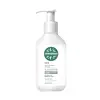What's inside
What's inside
 Key Ingredients
Key Ingredients

 Benefits
Benefits

 Concerns
Concerns

 Ingredients Side-by-side
Ingredients Side-by-side

Water
Skin ConditioningDisodium Cocoamphodiacetate
CleansingCarthamus Tinctorius Seed Oil
MaskingGlycerin
HumectantCocamidopropyl Betaine
CleansingCaprylyl Glycol
EmollientAcrylates/C10-30 Alkyl Acrylate Crosspolymer
Emulsion StabilisingPanthenol
Skin ConditioningSesamum Indicum Seed Oil
EmollientCaprylic/Capric Triglyceride
MaskingStearic Acid
CleansingAvena Sativa Kernel Flour
AbrasiveXanthan Gum
EmulsifyingAminomethyl Propanol
BufferingCaprylhydroxamic Acid
Rosa Canina Fruit Oil
EmollientTocopherol
AntioxidantCetearyl Alcohol
EmollientGlycine Soja Oil
EmollientBeta-Glucan
Skin ConditioningSodium Hyaluronate Crosspolymer
HumectantCitric Acid
BufferingWater, Disodium Cocoamphodiacetate, Carthamus Tinctorius Seed Oil, Glycerin, Cocamidopropyl Betaine, Caprylyl Glycol, Acrylates/C10-30 Alkyl Acrylate Crosspolymer, Panthenol, Sesamum Indicum Seed Oil, Caprylic/Capric Triglyceride, Stearic Acid, Avena Sativa Kernel Flour, Xanthan Gum, Aminomethyl Propanol, Caprylhydroxamic Acid, Rosa Canina Fruit Oil, Tocopherol, Cetearyl Alcohol, Glycine Soja Oil, Beta-Glucan, Sodium Hyaluronate Crosspolymer, Citric Acid
Water
Skin ConditioningCaprylic/Capric Triglyceride
MaskingCetearyl Alcohol
EmollientPolyglyceryl-3 Rice Branate
EmulsifyingPropanediol
SolventCoco-Caprylate/Caprate
EmollientButyrospermum Parkii Butter
Skin ConditioningPrunus Amygdalus Dulcis Oil
Skin ConditioningBenzyl Alcohol
PerfumingCetearyl Glucoside
EmulsifyingPolyglyceryl-10 Eicosanedioate/Tetradecanedioate
Skin ConditioningBetaine
HumectantAmmonium Acryloyldimethyltaurate/Vp Copolymer
Simmondsia Chinensis Seed Oil
EmollientGlycerin
HumectantDecyl Glucoside
CleansingTocopheryl Acetate
AntioxidantDehydroacetic Acid
PreservativeSodium Hyaluronate
HumectantTrisodium Ethylenediamine Disuccinate
Polyglutamic Acid
Skin Conditioning1,2-Hexanediol
Skin ConditioningCaprylyl Glycol
EmollientWater, Caprylic/Capric Triglyceride, Cetearyl Alcohol, Polyglyceryl-3 Rice Branate, Propanediol, Coco-Caprylate/Caprate, Butyrospermum Parkii Butter, Prunus Amygdalus Dulcis Oil, Benzyl Alcohol, Cetearyl Glucoside, Polyglyceryl-10 Eicosanedioate/Tetradecanedioate, Betaine, Ammonium Acryloyldimethyltaurate/Vp Copolymer, Simmondsia Chinensis Seed Oil, Glycerin, Decyl Glucoside, Tocopheryl Acetate, Dehydroacetic Acid, Sodium Hyaluronate, Trisodium Ethylenediamine Disuccinate, Polyglutamic Acid, 1,2-Hexanediol, Caprylyl Glycol
Ingredients Explained
These ingredients are found in both products.
Ingredients higher up in an ingredient list are typically present in a larger amount.
This ingredient is an emollient, solvent, and texture enhancer. It is considered a skin-softener by helping the skin prevent moisture loss.
It helps thicken a product's formula and makes it easier to spread by dissolving clumping compounds.
Caprylic Triglyceride is made by combining glycerin with coconut oil, forming a clear liquid.
While there is an assumption Caprylic Triglyceride can clog pores due to it being derived from coconut oil, there is no research supporting this.
Learn more about Caprylic/Capric TriglycerideCaprylyl Glycol is a humectant and emollient, meaning it attracts and preserves moisture.
It is a common ingredient in many products, especially those designed to hydrate skin. The primary benefits are retaining moisture, skin softening, and promoting a healthy skin barrier.
Though Caprylyl Glycol is an alcohol derived from fatty acids, it is not the kind that can dry out skin.
This ingredient is also used as a preservative to extend the life of products. It has slight antimicrobial properties.
Learn more about Caprylyl GlycolCetearyl alcohol is a mixture of two fatty alcohols: cetyl alcohol and stearyl alcohol. It is mainly used as an emulsifier. Emulsifiers help prevent the separation of oils and products. Due to its composition, it can also be used to thicken a product or help create foam.
Cetearyl alcohol is an emollient. Emollients help soothe and hydrate the skin by trapping moisture.
Studies show Cetearyl alcohol is non-toxic and non-irritating. The FDA allows products labeled "alcohol-free" to have fatty alcohols.
This ingredient is usually derived from plant oils such as palm, vegetable, or coconut oils. There is debate on whether this ingredient will cause acne.
Due to the fatty acid base, this ingredient may not be Malassezia folliculitis safe.
Learn more about Cetearyl AlcoholGlycerin is already naturally found in your skin. It helps moisturize and protect your skin.
A study from 2016 found glycerin to be more effective as a humectant than AHAs and hyaluronic acid.
As a humectant, it helps the skin stay hydrated by pulling moisture to your skin. The low molecular weight of glycerin allows it to pull moisture into the deeper layers of your skin.
Hydrated skin improves your skin barrier; Your skin barrier helps protect against irritants and bacteria.
Glycerin has also been found to have antimicrobial and antiviral properties. Due to these properties, glycerin is often used in wound and burn treatments.
In cosmetics, glycerin is usually derived from plants such as soybean or palm. However, it can also be sourced from animals, such as tallow or animal fat.
This ingredient is organic, colorless, odorless, and non-toxic.
Glycerin is the name for this ingredient in American English. British English uses Glycerol/Glycerine.
Learn more about GlycerinWater. It's the most common cosmetic ingredient of all. You'll usually see it at the top of ingredient lists, meaning that it makes up the largest part of the product.
So why is it so popular? Water most often acts as a solvent - this means that it helps dissolve other ingredients into the formulation.
You'll also recognize water as that liquid we all need to stay alive. If you see this, drink a glass of water. Stay hydrated!
Learn more about Water